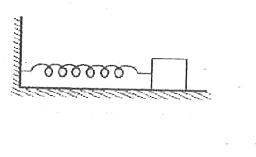Spring is mounted as shown in figure. By attaching a mass to the free end and pulling side ways, we determine that the force is proportional to the displacement a force of 4N causing a displacement of 0.02 m. We attach a 2kg body to the end, pull it aside through a distance of 0.04m , and then released. Find

the period and frequency of vibration.
The time period T=2π√mk
=2π√2200=π5 sec = 0.628 sec
Frequency f=1T=1.59s−1=1.59Hz
Angular frequency ω=2πf=10s−1
Similar Questions
Spring is mounted as shown in figure. By attaching a mass to the free end and pulling side ways, we determine that the force is proportional to the displacement a force of 4N causing a displacement of 0.02 m. We attach a 2kg body to the end, pull it aside through a distance of 0.04m , and then released. Find

the force constant of the springView SolutionSpring is mounted as shown in figure. By attaching a mass to the free end and pulling side ways, we determine that the force is proportional to the displacement a force of 4N causing a displacement of 0.02 m. We attach a 2kg body to the end, pull it aside through a distance of 0.04m , and then released. Find

maximum acceleration of the body.View SolutionSpring is mounted as shown in figure. By attaching a mass to the free end and pulling side ways, we determine that the force is proportional to the displacement a force of 4N causing a displacement of 0.02 m. We attach a 2kg body to the end, pull it aside through a distance of 0.04m , and then released. Find

the velocity adn acceleration when the body has moved half way in toward the central from is initial position.View SolutionSpring is mounted as shown in figure. By attaching a mass to the free end and pulling side ways, we determine that the force is proportional to the displacement a force of 4N causing a displacement of 0.02 m. We attach a 2kg body to the end, pull it aside through a distance of 0.04m , and then released. Find

How much time is required for the body to move half way into the center from its initial position?View SolutionSpring is mounted as shown in figure. By attaching a mass to the free end and pulling side ways, we determine that the force is proportional to the displacement a force of 4N causing a displacement of 0.02 m. We attach a 2kg body to the end, pull it aside through a distance of 0.04m , and then released. Find

maximum velocity atained by the body.View SolutionA rigid rod of mass m with a ball of mass M attached to the free end is restrained to oscillate in a vertical plane as shown in the figure. Find the natural frequency of oscillation.
 View Solution
View SolutionA spring of force constant 600Nm−1 is mounted on a horizontal table. A mass of 1.5 kg is attached to the free end of the spring,pulled sideways to a distance of 2 cm and released . The speed of the mass when the spring is compressed by 1 cm is
View SolutionFigure a) shows a spring of force constant k clamped rigidly at once end and a mass m attached to its free end. A force F applied at the free end stretches the spring. Figure b) shows the same spring with both ends free and attached to a mass m at either end. Each end of the spring in figure is stretched by the same force F.
(a) What is the maximum extension of the spring in the two cases ?
(b) If the mass in figure and the two masses in figure are released free, what is the period of oscillation in each case?
 View Solution
View SolutionFigure a) shows a spring of force constant k clamped rigidly at once end and a mass m attached to its free end. A force F applied at the free end stretches the spring. Figure b) shows the same spring with both ends free and attached to a mass m at either end. Each end of the spring in figure is stretched by the same force F.
(a) What is the maximum extension of the spring in the two cases ?
(b) If the mass in figure and the two masses in figure are released free, what is the period of oscillation in each case?
 View Solution
View Solution
A source S emitting sound of 300 Hz is fixed of block A which is attached to free end of a spring SA as shown in the figure. The detector D fixed on block B attached to the free end of spring SB detects this sound.
The blocks A and B are simultaneously displaced towards each other through of 1.0 m and then left to vibrate. Find the maximum and minimum frequencies of sound detected by D if the vibrational frequency of each block is 2 Hz (velocity of sound is 340 m/s).View Solution
